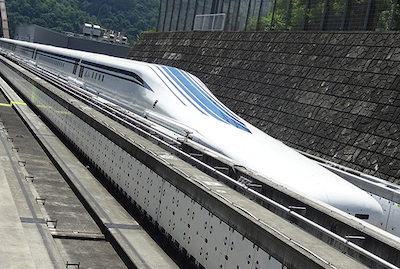When last we visited the maglev Chuo Shinkansen, or “linear motor car” in local parlance, construction had been delayed in Shizuoka Prefecture, where the governor, Heita Kawakatsu, had insisted work not proceed until the region’s water supply was addressed. If you want details about that particular problem, see our previous post on the matter here, but the problem itself hasn’t gone away in the two subsequent years, which is a long time for this particular project, already delayed significantly by other problems.
According to a Sept. 14 article in the Asahi Shimbun, Shin Kaneko, the president of JR Tokai, which is building the train line, has pledged to address the issue of “assuring water resources and conservation of the environment” surrounding the Shizuoka section of the line, which is only 8.9 kilometers in length and all underground. In order to deliver these assurances a meeting was held between Kaneko and Kawakatsu on Sept. 13, but the Asahi reports that nothing much was accomplished at the meeting, their first in two years and three months. Shizuoka’s main gripe is about the water in the Oi River, which is used by residents, and Kawakatsu has insisted that JR Tokai replace any water that is “lost” during construction, a demand that, on the surface at least, sounds difficult though JR Tokai has tentatively agreed, probably because the delay has become untenable and they have to say something to get things moving again. After all, JR Tokai still has 2027 set for completion of the maglev between Tokyo and Nagoya. For his part, Kawakatsu says adamantly that he is not “against” the maglev—Shizuoka finally joined the construction promotion group in July, the last prefecture affected by the maglev to do so. By all means, he wants to see it up and running. But given that Shizuoka doesn’t benefit from it—there will be no maglev Chuo Shinkansen station in the prefecture—he definitely isn’t going to give up something for nothing.
The matter was covered during a recent discussion on the web news show Democracy Times. Apparently, Kawakatsu made a remark to the effect that the maglev project should shoot for a more attainable short-term goal, like starting partial operation between Kanagawa and Yamanashi prefectures. Given the train’s high speed and the paucity of stations on that stretch of the maglev line, this almost sounds as if Kawakatsu is pulling somebody’s leg. Would anybody use the maglev for such short distances? The governor of Kanagawa was not amused and complained about the remark. As it happened, Kawakatsu had already gone to see for himself how construction was coming along in Kanagawa Prefecture and visited the Sagamihara Station construction site. There, he found out that JR Tokai is planning to build a railyard near the station that hasn’t even been started yet. Given that it will take 11 years to build, it would seem that there’s no way the yard could be completed by 2027. What’s worse is that JR Tokai hasn’t even finalized the purchase of all the land needed. Buying land has always been one of the most difficult aspects of the maglev project, which is why in Tokyo the line is being built 60 meters below the surface. Landowners’ rights don’t go that deep. According to Asahi Shimbun, this matter, which Kawakatsu wasn’t aware of before his inspection trip, caused him to become even more doubtful about the whole project.
And there’s more. An Aug. 30 article in Nikkei xTech explained how the huge machines used to dig the tunnels—which make up more than 80 percent of the maglev line—have been breaking down. Already, the machine digging the tunnel in the Shinagawa area has broken, or, more specifically, the part of the machine that injects the chemicals into the excavated soil and rock in order to make them easier to remove, has been damaged, and it can’t be fixed until “after 2023.” Also, the massive bit on the machine that is being used to remove the temporary concrete retaining walls of a vertical tunnel in Aichi Prefecture has also been damaged. Nikkei xTech points out that because so much of the maglev tunnel construction is at depths never before attempted, the whole construction process is almost experimental. In fact, the late JR Tokai president Yoshiyuki Kasai, who lobbied for the maglev project, used the construction of an automobile tunnel through the Hida region of the Japan Alps as a means of convincing the land ministry that construction of the maglev was feasible. The construction of the Hida tunnel, which is 10.7 km in length, was considered extremely difficult due to the weak rock structure, high ground water content, and height of the mountain, and it took 8-and-a-half years to complete. The government’s go-ahead for the maglev was granted in 2007, the same year the Hida Tunnel was finished. But as one reporter on Democracy Times pointed out, if it took more than 8 years to dig a tunnel 10.7 km long, how long will it take to complete the whole maglev route, which goes through similar geological environments? Obviously, 2027 is out of the question, but will anyone living today actually live long enough to ride the thing?

